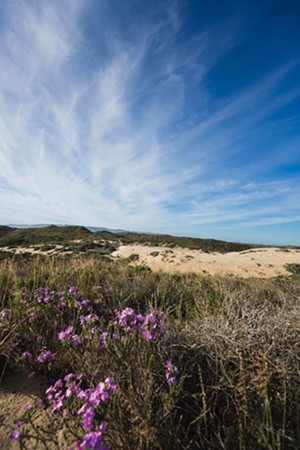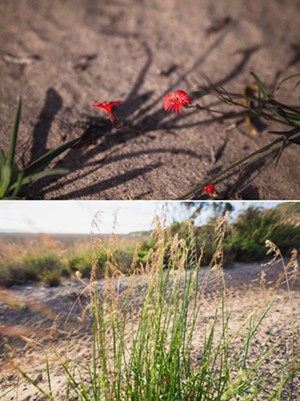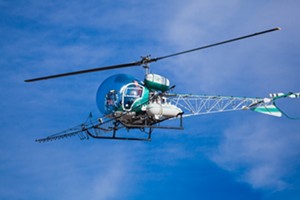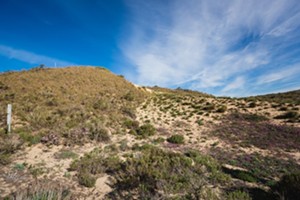View a slideshow of the Guadalupe dunes.
A helicopter rises from behind the hills, fields of strawberries and broccoli stretch for miles into the distance. The pilot moves toward a specific target, then releases a foggy, wet dust from a 17-foot spray boom, carpeting the ground—and, more specifically, the plants growing there. Clouds of herbicide sink through the morning air, floating over a series of 34-foot-wide plots.
The pilot has to occasionally return to refill the tank, each time landing with feather-light precision on the top of the truck the helicopter rode in on.

It’s a relatively common sight throughout the Santa Maria Valley, where flying craft are known to drop an assortment of pesticides and other chemicals on acres of crops that feed the nation. But on March 18, nobody was targeting fruits or vegetables; instead, the helicopter flew above the rugged, sandy dunes of the Guadalupe-Nipomo Dunes National Wildlife Refuge.
Spraying from above is the latest strategy local agencies are exploring to manage veldt grass, an invasive weed wreaking havoc on the scrub habitat that covers much of the 2,553-acre refuge at the heart of an 18-mile long coastal dunes complex. Veldt grass, often referred to as veldt, is native to South Africa. Since it was first introduced to California in the early 20th century, veldt has sprawled across much of the state’s coast. In some places—like Guadalupe and Montaña de Oro—it’s become one of the most formidable of all the invasive species being managed. In the dune scrub habitat—a place in constant flux as wind continuously forms and reshapes the dunes—veldt gained a foothold by colonizing the very open spaces and disturbed soils that native plants depend on.
Veldt is so well established in the Guadalupe dunes that the agencies in charge of managing the area decided to escalate their eradication methods.
That helicopter moving through the skies on March 18 applied two different herbicides as part of an experiment to test their efficacy for for managing veldt. The Land Conservancy of San Luis Obispo County, which has been involved in wildland management in the area since 1984 and more actively managing invasive species since 1999, is overseeing the tests. Above them all is the U.S. Fish and Wildlife Service (USFWS), which owns the refuge, said Jon Hall, restoration manager for the Land Conservancy.
The crux of the experiment: Can herbicides from above stop veldt in its tracks and create an opportunity for native plants to flourish—without significantly impacting the very native habitat everyone is trying to protect?
Unintended consequences
According to the California Invasive Plant Council, which boasts an extensive online library of invasive plants, the South African-native veldt grass has been in California since the 1930s. Three different species of veldt, or Ehrharta, populate the state: E. calycina [Smith], E. erecta [Lam], and E. longiflora [Brey]; or perennial veldt grass, panic veldt grass, and annual veldt grass, respectively. Perennial veldt grass, or Ehrharta calycina, is the species that’s moved into the Guadalupe-Nipomo Dunes National Wildlife Refuge and Montaña de Oro State Park, as well as several other locations throughout the coast, stretching south to areas around Vandenberg Air Force Base and the Gaviota coastal grassland terrace, and north to places like Bodega Bay in Sonoma County.
Several people familiar with the grass, including Hall, say that perennial veldt was first introduced to this area in the 1940s by the U.S. Soil Conservation Service—now the National Resource Conservation Service—which promoted the grass to ranchers as both an excellent source of forage for their cattle and an effective tool for erosion control. During that time, veldt was introduced to several areas within the Guadalupe dunes and planted on the Nipomo Mesa to be harvested for its seed and became popular among ranchers and the then-prolific dairy operations. The qualities that made it so effective at that time—vigorous growth, a preference for disturbed soils, and the ability to harness wind to spread and sow seeds—are the very things that now make veldt such a challenge to manage. Veldt is still present in rangeland areas, but it’s difficult to easily identify because cattle continue to eat it, preventing the tall, slender, reddish-brown leaf ends and seeds to mature.

Locally, veldt is the biggest reminder of how humanity’s best intentions of yesteryear can transform into a steep, uphill battle for the present population. Restoration crews wrestle with a long list of stubborn plants and grasses that were once introduced for a variety of reasons, including erosion control, cattle forage, or as a beautiful addition to landscapes. At times, the goal in managing invasive species is limited to stopping a plant or insect from proliferating further. At other times, it’s about subduing it and giving the upper hand back to the native species.
“The big idea in ecology is that we’re in the anthropocene now; we’re in this period where humans are altering the environment like crazy,” said John Chesnut, a Los Osos-based botanist who works extensively with native and non-native plants in the area.
Several management efforts have been employed locally to control veldt: the use of grazing, fire, hand pulling, and backpack sprayers. Biological forms of management, in which the habitat is manipulated to enable native plants to outcompete veldt, have also been used. But it’s hard to keep up, especially in places where veldt has such an extensive foothold: the Guadalupe dunes.
The dunes were particularly ripe for veldt’s colonization because of the amount of disturbed soil in the area, Chesnut said. Grazing, recreation, and pipeline construction have disturbed the soil in several places, creating a tumult that breaks whatever natural equilibrium was present and opens the space to the highest bidder, so to speak. In other words, the most competitive species wins.
The dunes disruption created corridors for the veldt to travel and seedbeds in which it can regenerate. It also complicated the dynamic relationship between dune scrub habitat and the foredunes, younger dunes found closer to the ocean. The relationship between the two habitats is where dunes evolve, as the sand shifts, soils change, and plants move from generation to generation, creating what Chesnut calls a “complex mosaic.”
The bottom line: Many people who are intimately familiar with the dunes are concerned that if they can’t get veldt under control, the plant will threaten many of the 144 imperiled, special status plant and animal species: 26 taxa of plants and 118 taxa of invertebrates, amphibians, birds, reptiles, and mammals that are on some sort of list, including endangered or protected species, according to the environmental assessment prepared by the USFWS.
Much of the focus is on the plant life, which is more visibly affected by veldt and plays host to the plethora creatures inhabiting the dunes. Scientists have identified a total of 216 plants on the dunes, and of the 26 plants listed as imperiled, several are smaller, annual flowering ones (which grow in the spring and then die back before winter) that rely on open sand between the larger bushes—the exact area veldt inhabits.
Plants with yellowish flowers include cryptanthan (popcorn flower), the dune wallflower, fiddleneck, and primrose. Mountain pennyroyal has light purple flowers. Phacelia distans (or distant scorpionweed) has brilliant blue flowers. The fringed Indian pink has delicate reddish-pink flowers. The ubiquitous state flower, the California poppy, dots the dunes with orange. Among the most memorable flora is the crisp dune mind, a small bluish-green plant with purple flowers, which Wesley Meyers, a member of the restoration crew that escorted the Sun into the protected wildlife refuge on March 18, said was “about the best smelling plant you’ll ever encounter.”
It’s difficult to argue with that claim. A light rub of the leaves releases a pungent aroma, similar to mint and sage. Later that morning, while heading back after traipsing through the rugged, hilly dunes, that familiar smell returned as a leg brushed up against a small plant that stood only about a foot wide and a few inches off the ground.
Other, more sturdy, larger, and shrubby perennial plants make up the foundation of the dunes, creating stability for the rest of the habitat to flourish, including the silver-bush lupine, coyote bush, and mock heather. Creatures big and small thrive in this mix, among them lizards, birds, bobcat, and deer—and the mountain lions that follow them in. Closer to the ocean, Oso Flaco Lake features some of the most impressive bird watching in the area.
Wildlife depends on plant life, of course, and veldt is so well established that it’s prompting a lot of concern.
With the help of Meyers’ trained eye, the foliage covering the hillsides became distinct for the Sun team; the reddish-brown tips at the end of the bunchy veldt grass stood out from the lighter, bluish-green shaded silver dune lupine; the stocky, woody coyote bushes; and the rainbow of colorful flowers that popped out among them. Several hillsides are thoroughly colonized by veldt grass, and it’s difficult to distinguish it by anything other than the bunched, reddish-brown hues of its foliage.

The current concern is that seeing nothing but veldt will become the norm. According to the USFWS environmental assessment written for the aerial spraying experiment: “If left uncontrolled, this highly invasive species would continue to invade native habitats on the Refuge where it would outcompete and overgrow native plant species. Such an event would ultimately lead to the conversion of nearly all of the natural sand dune and Central Coast dune scrub habitats on the Refuge to large monocultures of perennial veldt grass. This would result in a catastrophic loss of both rare habitats and imperiled species, including designated critical habit at units, federally listed species, and state listed species.”
The environmental assessment continues: “In an effort to provide protection and restoration for wildlife habitats and to provide protection and recovery for wildlife species, it is necessary to implement a treatment method for control of perennial veldt grass that is both environmentally safe and efficient, and is also effective on a landscape level.”
In comes the helicopter-spraying experiment.
The human hand
Whenever land management is discussed, there’s bound to be an assortment of approaches and debate over what constitutes the best management practices. That’s especially true when herbicides and pesticides are involved. The subtle irony at hand—an herbicide being tested for wildland habitat management—isn’t lost on the project managers. But with veldt on the rise even after decades of costly, labor-intensive management via backpack sprayers and hand removal, aerially spraying herbicides seems practical.
The environmental assessment, which has been reviewed and approved, detailed both the alternatives to spraying and the projected impacts.
The assessment found the alternatives—many of which have already been employed and also bring their own set of impacts—to be insufficient. The use of heavy machinery to pull out the grass can be damaging to historical and cultural resources; grazing has been associated with eutrophication (the over-enrichment of nutrients, which suffocates the life cycle) of ponds and wetlands, cattle hooves trample plants and may facilitate the movement of other invasive species, and the lack of fencing makes it unmanageable; controlled burns would adversely impact air quality; and utility terrain vehicles would likely cause more harm than good in terms of impacts to the ground and wouldn’t be able to access to much of the steep slopes inhabited by the veldt.
As for backpack sprayers and hand pulling, those are the best technique so far, but they’re both very expensive and can’t keep up. To get to the veldt by foot requires a lot of hiking and hauling of materials, plus it costs about $300 an acre. Aerial spraying is estimated to cost about $30 an acre.
“That’s a huge cost savings when you are looking at managing weeds in a 22,000-acre dune system,” Hall wrote in an email, referring to the larger goal of adding aerial spray to the portfolio of management options to the greater dune system, not just the refuge.
Currently, the Land Conservancy and the USFWS are testing an herbicide that isn’t presently approved for wildland application: Arrow 2EC, a clethodim used for weed management. The Land Conservancy believes the chemical, which specifically targets grasses, will be more effective than another chemical—a sethoxydim called Poast—which is approved for wildland application. The spraying, which began March 18 and is targeting the veldt while it goes to seed, is aimed at 10 separate 2-acre plots; five will receive one chemical, and another five will receive the other. Ten additional control plots will receive no treatment.
The objective is to see if Arrow 2EC has more effect than Poast, and to assess how much impact there is to native plants. Additional measurements are assessing how much herbicide drift occurs, so they can create effective buffers between the areas being sprayed and wetlands and other sensitive areas.
The environmental assessment outlines projected impacts as being rather minimal, claiming that the net impacts would be beneficial. The spray doesn’t affect most of the native plants, and native grasses are few in the area. Only two of the 144 imperiled species are considered to likely be impacted: the California legless lizard and the Morro blue butterfly.

The assessment addresses those: “Due to low toxicity of the applied herbicide, low herbicide spray volumes, and the potential for restoring wildlife habitat, the net cumulative effects on the California legless lizard and Morro blue butterfly would likely be beneficial. Since the California legless lizard primarily lives in subterranean habitat, it would not likely be substantially exposed to direct herbicide applications.”
As for whether chemical application is the best or most popular management method may be a larger debate. The Pesticide Research Institute, a Berkeley-based organization that examines the effects of herbicides and pesticides, couldn’t be reached for comment. Chesnut, who’s worked extensively within the Dunes Complex, opted to not be involved with the aerial spraying experiment, but still recognized the project’s justification, as veldt is out of control. He raised an interesting question, however, about what happens afterward. Referring to the “finish” aspect of the spraying, or the process in which the native plants rebound, Chesnut notes that in the long-term picture, the dune shrub plant community will need to be able to protect and manage itself.
That transition from the removal of the existing veldt to a habitat that gets back into the natural cycle can be a puzzle. Chesnut considers the silver dune lupine to be a key in this process, because as a pioneer species, its heavy foliage can shade the soil and outcompete veldt while allowing for other native plants to flourish. He also sees a potential piece to the puzzle in a fungus currently being studied at Cal Poly, which infects veldt seeds. However, when it comes to biological management, things get very complicated.
“Grassland ecosystems are notoriously resilient—they, after all, have evolved with tremendous grazing pressure,” Chesnut said in an email. “Transitioning back from grassland to chaparral is not easy or straightforward.”
Hall is familiar with these points, and in many ways agrees with Chesnut.
“He is definitely correct. Regeneration of the Dune habitat seems to be very slow to recover once the veldt grass is removed,” Hall said. “Due to funding and time limitations, this experiment is only designed to answer a few key questions.”
Those questions are: Is the aerial application of a grass-specific herbicide effective on veldt grass? What is the cost? What is the impact to natives? What size of buffer is necessary?
Even if the experiment yields successful results, there’s a long road ahead, full of more permitting and complicated approaches to management. For now, funding exists only for this year.
“Any successful weed management program needs to have many techniques integrated together for the overall management strategy,” Hall wrote in an email. “Basically, if you keep hitting the plant with a right hook, you can beat the population down to a point, but you need to switch it up with some uppercuts to finish the job. There is never one silver bullet that will fix the problem for you. Nature always finds a way to adapt to the treatment you are imposing on it, so you need to continually switch it up so it doesn’t get the chance to adapt.”
Jono Kinkade is a staff writer for New Times, the Sun’s sister publication. Contact him at [email protected].
Native species could flourish in the Guadalupe dunes, but management agencies need to figure out how to box out the invasive species first. See images of both.
PHOTOS BY KAORI FUNAHASHI










